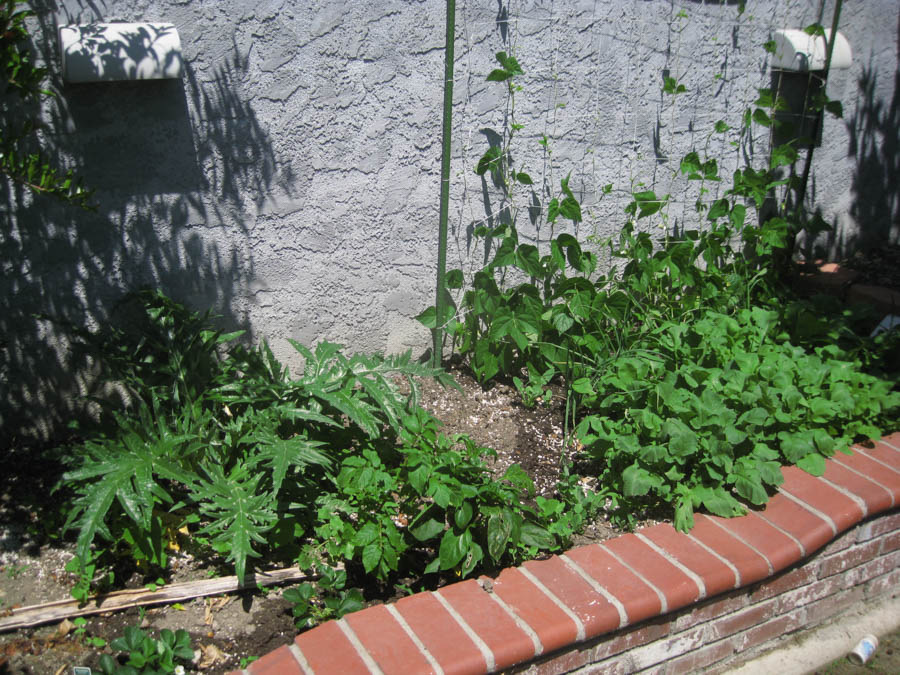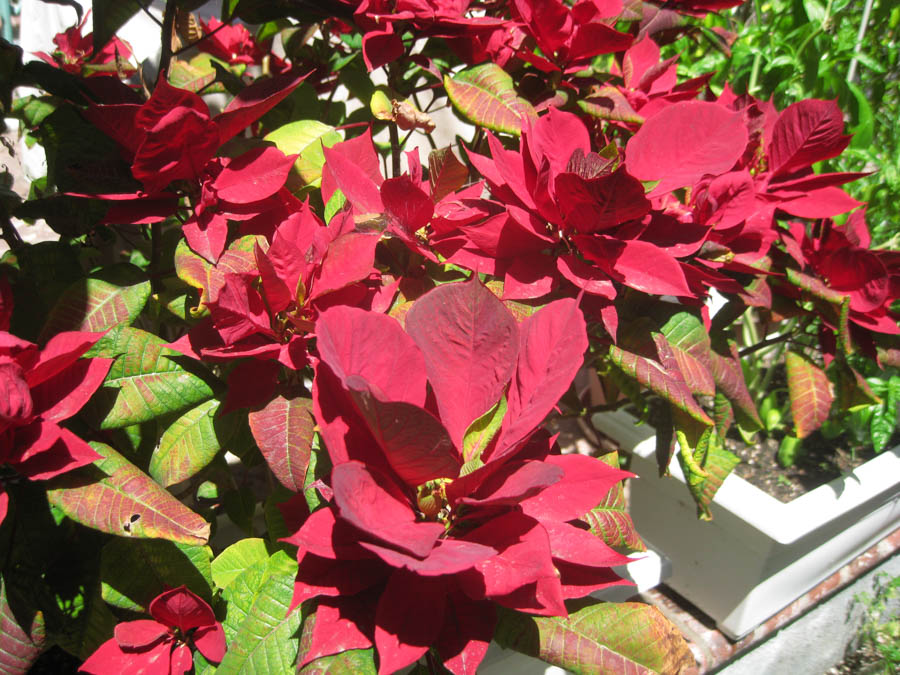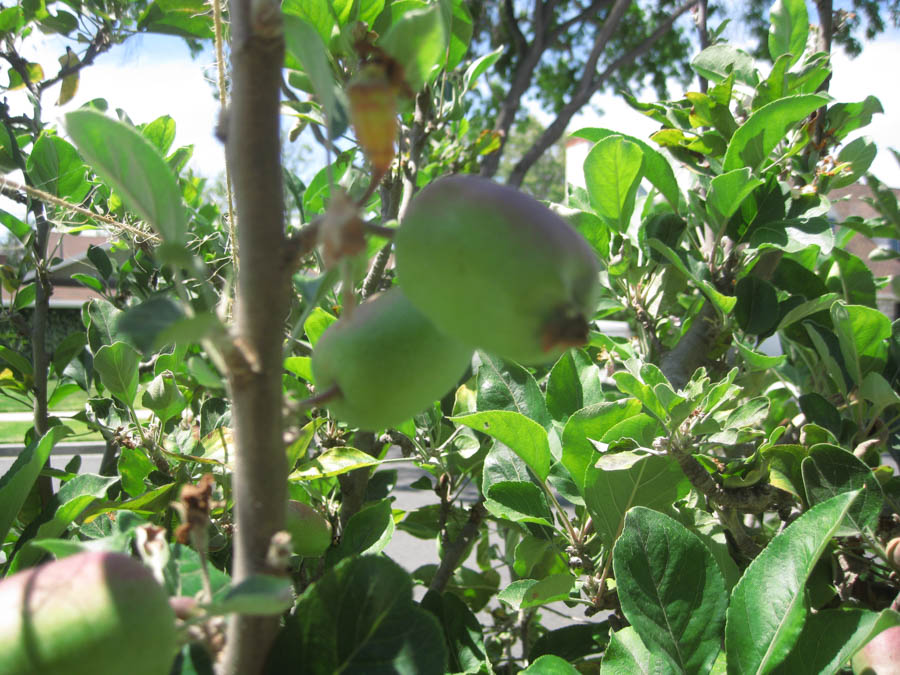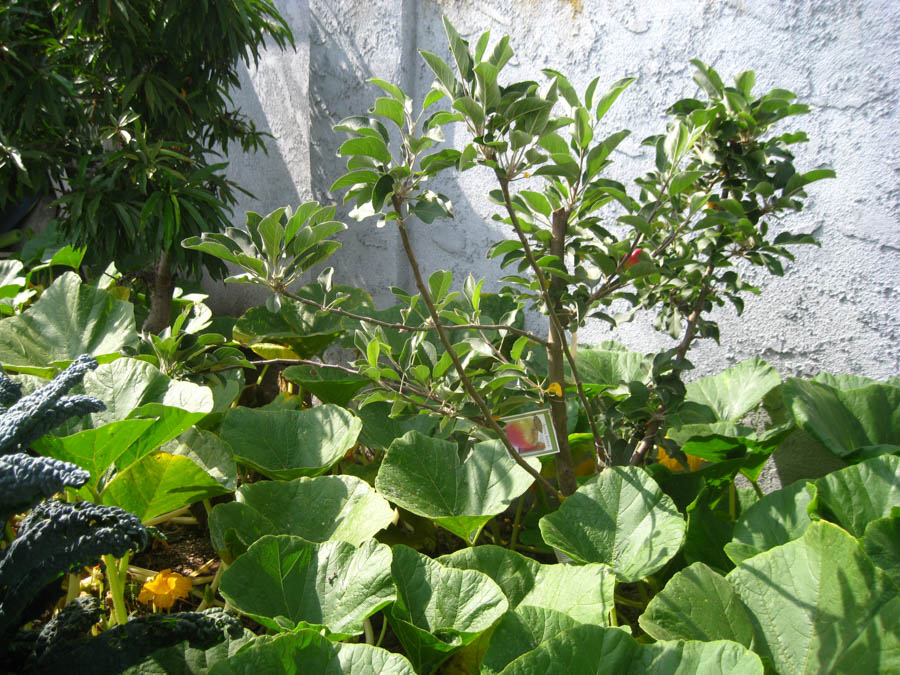It's May 1st... How Is It Going In The Garden?


Harvesting the cauliflower.... It had to be done!
Harvesting the cauliflower....
Crenshaw melons take their place

The leaves go to the composter and in in months
will return to the garden in different form


One cauliflower standing...

We are going to grow the melons vertically


They are planted, caged, and mulched. All we need is 60 days!
Did You Know? - Muskmelon (Cucumis melo) is a species of melon that has been developed into many cultivated varieties. These include smooth skinned varieties such as honeydew, crenshaw and casaba, and different netted cultivars (cantaloupe, Persian melon and Santa Claus or Christmas melon). Cantaloupe melons are an excellent source of vitamin A and vitamin C, and a good source of potassium.

The kale seems to be doing well...
These will be kale chips by the weekend!

The watermelons are going wild...
We made them vertical to save space and get more sun!

What are these? Peanuts! In a month or so we will have a bag of peanuts!


Our back (East) wall is going like gang busters!

The green beans are over seven feet tall already!

Bell peppers anyone?

Our first large tomatoes are coming indoors this weekend!

The northern wall is loaded with nine types of tomatoes

Do not cry yet.... But soon!
Did You Know? - The onion plant has a fan of hollow, bluish-green leaves and the bulb at the base of the plant begins to swell when a certain day-length is reached. In the autumn the foliage dies down and the outer layers of the bulb become dry and brittle. The crop is harvested and dried and the onions are ready for use or storage.
Routine care during the growing season involves keeping the rows free of competing weeds, especially when the plants are young. The plants are shallow-rooted and do not need a great deal of water when established. Bulbing usually takes place after twelve to eighteen weeks. The bulbs can be gathered when needed to eat fresh, but if they will be kept in storage, they should be harvested after the leaves have died back naturally. In dry weather they can be left on the surface of the soil for a few days to dry out properly; then they can be placed in nets, roped into strings or laid in layers in shallow boxes.

Each of our 32 tomatoes are labeled with white tags

To The Side Yard (The Southern Wall)

Getting ready for halloween... Pumpkins are underway
Did You Know? - The word pumpkin originates from the word pepon (πέπων), which is Greek for "large melon", something round and large. The French adapted this word to pompon, which the British changed to pumpion and later American colonists changed that to the word that is used today, "pumpkin".

Kale and beets living in peace
Did You Know? - Kale or borecole (Brassica oleracea Acephala Group) is a vegetable with green or purple leaves, in which the central leaves do not form a head. The name borecole most likely originates from the Dutch boerenkool (farmer's cabbage), whereas kale bears semblance to the Danish and Swedish kål and to the German Kohl (a general term for various kinds of cabbage) and Scottish Gaelic càl (or kail, as in Kilmany Kail; a rabbit, salt pork and kail broth from Kilmany in Perth, Scotland). Some varieties can reach a height of six or seven feet; others are compact and symmetrical and of good quality for eating.
During World War II, the cultivation of kale in the U.K. was encouraged by the Dig for Victory campaign. The vegetable was easy to grow and provided important nutrients to supplement those missing from a normal diet because of rationing.




The Anaheim chilies are getting ready to be picked!

Our new fig trees have about 20+ figs starting to grow on them!
Did You Know? - The edible fig is one of the first plants that was cultivated by humans.
Two crops of figs are potentially produced each year. The first or breba crop develops in the spring on last year's shoot growth. In contrast, the content fig crop develops on the current year's shoot growth and ripens in the late summer or fall. The content crop is generally superior in both quantity and quality to the breba crop.


We have space for one more small tree
Front Yard (West Facing)

The spaghetti squash is going wild!
By the end of the season,
it will be over 25 feet long!
Did You Know? - Spaghetti squash (also called vegetable spaghetti, noodle squash, vegetable marrow, spaghetti marrow, and squaghetti) is a group of cultivars of Cucurbita pepo subsp. pepo. The fruit can range either from ivory to yellow or orange in color. The orange varieties have a higher carotene content. Its center contains many large seeds. Its flesh is bright yellow or orange. When raw, the flesh is solid and similar to other raw squash; when cooked, the flesh falls away from the fruit in ribbons or strands like spaghetti.
Spaghetti squash can be baked, boiled, steamed, and/or microwaved. It can be served with or without sauce, as a substitute for pasta. The seeds can be roasted, similar to pumpkin seeds.

Tomatillos and squash are enjoying the morning sun!

Yes indeed... We have artichokes, string beans and radishes
Strawberries are down low

The pomegranate tree is sporting about 10 blooms... It's just a baby!

Did You Know? - The pomegranate is considered to have originated in the region of modern day Iran, and has been cultivated since ancient times throughout the Mediterranean region and northern India. It was introduced into Latin America and California by Spanish settlers in 1769.


These little guys are hiding from Vicky!
Vicky is our next door neighbor...

The Japanese grapes are going well... We are trying herbs
in the front of this bed
this year! It was normally used for tomatoes!

We have berries
that are beginning to form

Did You Know? - In the late 1920s, George M. Darrow of the USDA began tracking down reports of a large, reddish-purple berry that had been grown on Boysen's Northern California farm. Darrow enlisted the help of Walter Knott, a Southern California farmer who was known as a berry expert. Knott had never heard of the new berry, but he agreed to help Darrow in his search.
Darrow and Knott learned that Boysen had abandoned his growing experiments several years earlier and sold his farm. Undaunted by this news, Darrow and Knott headed out to Boysen's old farm, on which they found several frail vines surviving in a field choked with weeds. They transplanted the vines to Knott's farm in Buena Park, California, where he nurtured them back to fruit-bearing health. Walter Knott was the first to commercially cultivate the berry in Southern California. He began selling the berries at his farm stand in 1932 and soon noticed that people kept returning to buy the large, tasty berries. When asked what they were called, Knott said, "Boysenberries," after their originator. His family's small restaurant and pie business eventually grew into Knott's Berry Farm. As the berry's popularity grew, Mrs. Knott began making preserves, which ultimately made Knott's Berry Farm famous.

The only thing that is not edible in the garden!

Salad is underway!
These are replants as we devoured the
previous plants already this season... We replaced the bolted plants!.
Did You Know? -
Bolting is when agricultural and horticultural crops prematurely produce a flowering stem (or stems) before the crop is harvested, in a natural attempt to produce seeds and hence reproduce. These flowering stems are usually vigorous extensions of existing leaf-bearing stems, and in order to produce them, a plant diverts resources away from producing the edible parts such as leaves or roots, resulting in a poor quality harvest from the grower's point of view. Plants that have produced flowering stems in this way are said to have bolted. Crops inclined to bolt include lettuce, beetroot, brassicas, spinach, celery and onion.
Bolting is induced by plant hormones of the gibberellin family and can occur as a result of several factors, including changes in day length, the prevalence of low temperatures at particular stages in a plant's growth cycle, and the existence of stresses such as insufficient water or minerals.

These little guys will be a salad tomorrow!
The Front Yard Outside The Wall

On our parkway the apple tree is enjoying a heavy harvest!

These will be applesauce in the near future

There is probably 100 apples on the tree!
There are three difference kinds of apples on this single tree!

Our new plum tree is also loaded!


Can you see all the plums?

From left to right - Lime, plum, and kumquat!
June 27th In The Garden

Great day in the garden

The pumpkins are going wild!
Did You Know? - The word pumpkin originates from the word pepon (πέπων), which is Greek for "large melon", something round and large. The French adapted this word to pompon, which the British changed to pumpion and later American colonists changed that to the word that is used today, "pumpkin".
As one of the most popular crops in the United States, 1.5 billion pounds (680,000,000 kilograms or 680,000 tonnes) of pumpkins are produced each year. The top pumpkin-producing states include Illinois, Indiana, Ohio, Pennsylvania, and California.

The corn is taller than the avacado tree!

The fruit is forming
quite well

A forest of corn
Did You Know? - Maize (/ˈmeɪz/ MAYZ; Zea mays subsp. mays, from Spanish: maíz after Taíno mahiz), known in some English-speaking countries as corn, is a large grain plant domesticated by indigenous peoples in Mesoamerica in prehistoric times.
The leafy stalk produces ears which contain the grain, which are seeds called kernels. Maize kernels are often used in cooking as a starch. The six major types of maize are dent, flint, pod, popcorn, flour, and sweet.

Another few weeks and it will be time to pick
Did You Know? - Sweet corn (Zea mays convar. saccharata var. rugosa; also called sugar corn and pole corn) is a variety of maize with a high sugar content. Sweet corn is the result of a naturally occurring recessive mutation in the genes which control conversion of sugar to starch inside the endosperm of the corn kernel.
Unlike field corn varieties, which are harvested when the kernels are dry and mature (dent stage), sweet corn must be picked when immature (milk stage) and prepared and eaten as a vegetable, rather than a grain.
Since the process of maturation involves converting sugar to starch, sweet corn stores poorly and must be eaten fresh, canned, or frozen, before the kernels become tough and starchy.

We can almost smell the corn now

The tassels are turning
Did You Know? - The ear is covered by tightly wrapped leaves called the husk. Silk is the name for the pistillate flowers, which emerge from the husk. The husk and silk are removed by hand, before boiling but not before roasting, in a process called husking or shucking.

The pumpkin is beginning to form

Another 45 days and it will be 24 inches around and a golden orange

It is shading the bark on the apple treee.... This is good

A female flower is the one that produces the pumpkins
Did You Know?
● In early colonial times, pumpkins were used as an ingredient for the crust of pies, not the filling.
● Colonists sliced off pumpkin tips; removed seeds and filled the insides with milk, spices and honey. This was baked in hot ashes and is the origin of pumpkin pie.
● Pumpkins were once recommended for removing freckles and curing snake bites.
● The largest "official" pumpkin ever grown weighed 1,340 pounds.
● The largest "unofficial" pumpkin ever grown weighed 1'458 pounds, but was not awarded due to damage.
● The Connecticut field variety is the traditional American pumpkin.
● Pumpkins are 90 percent water.
● Eighty percent of the pumpkins supply in the United States is available in October.

The kale is also doing well

Hot peppers anyone? These are habaneros

More hot peppers

The bell peppers are doing quite well
Did You Know? - Bell peppers are a great source of vitamin C. If you thought citrus fruits packed a powerful punch when it comes to being a good source of vitamin C, peppers have them beat. Green peppers have twice the amount of vitamin C by weight than citrus fruits, and this powerful punch of vitamin C is an antioxidant that may be effective in preventing certain cancers. Red bell peppers have three times as much vitamin C as the green varieties and are a good source of beta carotene.

Turning colors daily

Time to stuff them!

Anaheim chilies will soon be stuffed

Love the colors

A purple bell sticks his little head out

Eggplant and peppers seem to get along well

New onions and beets on their way
